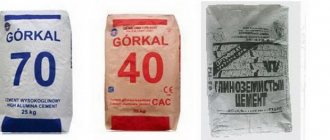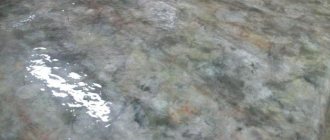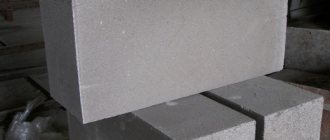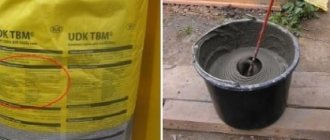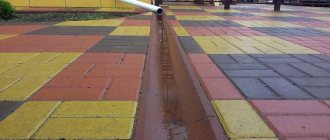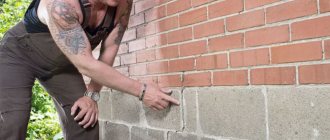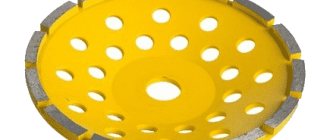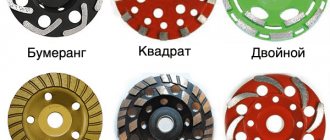Without this material it is impossible to imagine a modern construction site. For more than a hundred years, cement has made it possible to build the strongest structures, it is used for repair work, it is used to decorate premises, but few people think about what cement is made of.
So what is cement? This material is a powder based on inorganic compounds. Interacting with water, this powder begins to harden and acquire the strength of a monolithic, strong material, filling a pre-prepared form.
The reaction occurs when sufficient moisture is provided. After gaining strength, cement structures can serve for a long time without changing their basic properties. Plants involved in the production of this material try to be located in close proximity to the source of raw material extraction, since the volume of processing and transportation of materials for the production of cement is quite high.
To understand what cement consists of, it is enough to show the chemical composition of the cement most used in construction - Portland cement. It is made using the following proportions:
- calcium oxide – at least 60%;
- silicon dioxide – not less than 20%;
- alumina – no less than 4%;
- iron oxide – not less than 2%;
- magnesium oxide – not less than 1%.
The formulas of other types of cement are similar, only the amount of each ingredient is adjusted.
Compound
Cement is produced at specialized enterprises.
Cement factories are built in close proximity to the places where raw materials are extracted. The raw materials for its production are obtained from natural rocks:
- carbonate type fossils;
- clay materials.
Carbonates have an amorphous or crystalline structure, which determines the effectiveness of the interaction of the material with other components during the firing process.
Carbonate rocks include:
- chalk;
- marl (marly limestone);
- limestones, including shell rocks;
- dolomite type rocks.
Clay materials are sedimentary rocks. Possessing a mineral base, they are endowed with plasticity, and with excess moisture they can increase in volume. Clay materials are used in the dry manufacturing method.
Clay rocks include:
- clay;
- loams;
- clay-based shales;
- loess.
In addition to raw materials, corrective additives are used in the production of cement.
They are obtained from fossils, which include:
- apatites;
- alumina;
- fluorspar;
- silica.
Additives introduced using a certain technology improve the quality of the material being described.
The composition of cement depends on the required characteristics, which are determined by the grade assigned to the material.
The most popular Portland cement consists of:
- 60% lime;
- 25% silicon dioxide;
- 10% iron oxides and gypsum;
- 5% aluminum (alumina).
In different brands, the percentage of starting materials differs, as does the composition itself. For example, Portland slag cement contains slag. Quantitative proportions may also change depending on the characteristics of the chosen manufacturing technology for the building material.
For any brand of cement and for any method of its production, limestone and clay remain unchanged. Moreover, limestone is always three times more clay. This ratio contributes to the production of high-quality clinker, from which cement is made.
In industry, the following components are used to produce cement:
- clinker;
- gypsum;
- special additives.
Clinker is the most significant component of cement. It determines the strength qualities of the final material. Clinker enters the production process in the form of granules. The diameter of the granules varies between 10-60 mm. Heat treatment of the component is carried out at a temperature of about one and a half thousand degrees.
The amount of gypsum is determined by the established curing period. In the basic version, gypsum in powder form is included in cement in a volume of 6%.
Raw materials for preparation
They try to plan the location of cement production near the main reserves of raw materials. The raw materials are natural rocks mined by open-pit mining. So, what is cement made from?
- Carbonate rocks. These include: chalk; shell rock and other limestones; dolomite; marl. Limestone rocks are mainly used in industrial production. This material makes it possible to increase the efficiency of interaction during the firing process.
- Clay rocks. These include: clay; clayey shales; loams; loess. This material is necessary to achieve the plasticity of the mixture and is used mainly in the production of cement using the dry method.
- Supplements To obtain certain qualities of a cement mortar, it is necessary to add substances to the base composition that can adjust the properties of the material. Additives include: alumina; silica; fluorspar; apatites.
Additives to cement.
Peculiarities
When mixed with water, this popular powder material hardens into a petrified lump. Hardening occurs when there is excessive air humidity or the presence of liquid
The presence of water is an important condition for hardening the finished product.
Depending on the composition, there are several types of cement. Each of them has a degree of hardness unique to it, and the brand and quality of the product are determined by it. Cement, which is made from rocks, is quite reliable. It is made only from quality materials.
Portland cement is the most widely used type of mineral composition, which is also called silicate cement. It hardens in an aquatic environment and in proximity to moist air. The gray-green powdery substance dissolves easily in water when mixed. Once the mixture begins to set, slow hardening begins.
Portland cement is included in the formulation of almost all groups of cement mixtures. The use of this brand in its pure form is a very rare occurrence. Basically, it is part of mixtures, building concrete, and mortars.
Plasticized cement has great advantages over other types. Its use helps reduce costs and time for mixing dry mixtures. The composition is not exposed to low temperatures, excessive humidity, evaporation and other negative influences of the external environment.
Slag cement contains blast furnace slag and crushed clinker. This brand contains additional substances in the form of lime powder and gypsum. Such cement is necessary when combining building mixtures.
Highly active alumina cement has a unique composition. The time before hardening begins is only 45 minutes. It takes about 10 hours for the solution to completely harden. The main advantage of this composition over others is that, regardless of the saturation of the air with moisture, it quickly sets. When this type of cement is added to concrete, new qualitative characteristics appear in it: resistance to dampness, corrosion, and large temperature changes.
The main components of acid-resistant cement composition are sodium silicofluoride and quartz sand. A solution of such a substance cannot be obtained in ordinary water. To prepare a mixture of this powder, liquid glass is used, which is based on sodium. The advantages of acid-resistant cement are that it is very resistant to mineral and organic acids. But with their presence and use, the service life decreases very quickly.
Colored cement contains simple Portland cement to which pigments have been added. This brand is used to decorate buildings and is part of the compositions that are used in the construction of highways based on concrete mixtures. When mixed with water, Portland cement forms a material with a plastic structure. As it dries, it turns into stone.
The advantages of this substance:
- hardening without external effort;
- highly durable and hard substance obtained after hardening;
- increased chemical safety;
- it is an environmentally friendly product;
- fire safety;
- low cost;
- versatility.
White cement is a powder that acquires its light color with specialized production technology and a certain composition. Its recipe contains clinker with a low iron content and contains mineral additives of limestone, chloride compounds, and gypsum. This composition gives the mixture light shades.
Deciphering cement markings according to new standards
Coding of product information according to GOST 31108-2003 is based on dividing cement types into 5 groups, designated by Roman numerals. The first 3 letters are taken from the name of the powder - CEM.
Each association has characteristics indicating manufacturing features:
- I - Portland cement without additives, consists of 95-100% cement clinker;
- II - this group is divided into subclasses A with additives of 6-20% and B - 21-35%. Pozzolanic cements containing
- III - Portland slag cement with a slag content of 36-65%;
- IV - pozzolanic cement with an addition of 21-35%;
- V is a composite powder containing 11-30% slag and pozzolan within the same limits.
Each of the additives has its own letter in the designation: I - limestone, Z - fly ash, MK - microsilica, K - composite additive, G - gliezh, Sh - slag, P - pozzolan. This is followed by the strength class number, followed by the letters: N - normal hardening time, B - rapid setting. Example: Portland slag cement CEM III/A 32.5N GOST 31108-2003. It is deciphered as follows: the strength of cement is 32.5 MPa, it is normally hardening, and contains 36-65% slag.
How cement is prepared in production
The main substances from which cement is produced are limestone and clay. From these two components, clinker is prepared in a special way, which is subsequently mixed with other additives that determine the quality, brand and properties of the solution. Mandatory additives include: gypsum, dolomite, cementite.
Stages of cement production.
In nature there is clinker in its pure form - marl, but due to the small reserves of this mineral, it is not possible to use it on an industrial scale, so domestic and foreign manufacturers prepare clinker from traditional materials.
Marl.
Cement production is divided into the following stages:
- To prepare clinker, you need to thoroughly mix the ingredients in special large-capacity drums.
- At the next stage, the prepared mass enters the oven, where firing occurs for 3-4 hours at a temperature close to one and a half thousand degrees. As a result, clinker is formed in the form of small fractions (up to 5 cm in diameter).
Sludge roasting.
- Next, the resulting clinker grains are crushed in drums using ball screens. During the processing of the material, it is necessary to achieve a powdery state of the mixture.
- At the final stage, the necessary additives are added to the finished cement and sent for packaging in bags or hoppers.
There are three ways to make cement. They differ in clinker processing techniques.
- Wet method. Clinker is produced using water, chalk and clay. As a result of mixing substances in the drum, a wet mass is formed - a charge. It is sent for firing, after which the resulting granules are crushed and mixed with the necessary additives. This method is considered quite expensive, so other methods are now more often used.
- Dry method. Allows you to shorten the stage of mixing the finished mixture with additives, since the whole process comes down to preparing, crushing and mixing ready-made ingredients. This technology is becoming increasingly popular, as it can significantly reduce production costs and the final price of the product.
- Combined method. This technology uses various forms of clinker production, combining the production steps used in dry and wet methods.
How cement is made in production
Today there are several production methods:
The wet method is the first technology used to produce cement. They still use it to this day, albeit with slightly improved methods. The dry method is a more modern method of producing binder, characterized by greater savings in raw materials and energy resources.
But, most importantly, it is this technology that reduces emissions into the atmosphere. Combined techniques are rarely used in Russia, mainly at enterprises working with foreign partners. For example, like the Volsky cement plant.
However, I wanted to cover in more detail the wet method of cement production, since almost all cement factories in Russia and the CIS countries operate using it. The photo below shows the production facilities of Uralcement in the Chelyabinsk region, which began operating in 1957. Here, the binder is produced using limestone and clay using the wet method. Gas is used as fuel. Production in the quarry begins with the extraction of the main raw materials.
Extraction of limestone and clayLimestone quarry
Next, the extracted raw materials are further processed and entered into a wet grinding furnace, where they are turned into sludge. After which the sludge goes further to raw mills and sludge pools.
Raw material processing
The resulting fine sludge is sent to a rotary kiln, where it is fired at a temperature of +1450°C. The result of this process is clinker.
Sludge firingControl of firingThe resulting clinker is cooled in special refrigeration units, after which it is transported for further grinding in a mill.
Transportation of clinker
Clinker Mill
Fine gypsum and mineral additives are also added to the crushed clinker.
Ingredient mixing process
The finished cement is sent for storage in special bunkers.
Bunkers
Such a large production enterprise simply cannot have a laboratory whose employees closely monitor every production process and the quality of cement.
Cement testing
These are the main production processes using wet technology. They are identical at all factories. The only thing is that adjustments are made to the raw materials and the specifics of the equipment. The video will tell you in detail what and how cement is made from.
Watch this video on YouTube
Watch this video on YouTube
Limestone processing
Diagram of a cement production plant
At a cement production plant, rock is unloaded into an apparatus for primary crushing of stones. Large boulders, under the influence of a pressing force of several tons, are gradually crushed to the size of a tennis ball and enter the conveyor. Small and large stones are sent to secondary crushing, where they are reduced to the size of a golf ball and into a fine powder. Limestone, with different percentages of calcium carbonate content, is processed separately.
Diagram of the line for grinding and drying limestone: 1 – belt feeder PL-650; 2 – magnetic separator; 3 – drying complex; 4 – elevator; 5 – supply hopper with a gate head; 6 – belt feeder PL‑500; 7 – mill MTsV-3; 8 – rotary-jet mill MRS-2/770; 9 – cyclone-hopper TsB-4.5; 10 – dust collector II PC-2.0 with hopper; 11 – bag filter FRI-60; 12 – sector feeder PS-1V; 13 – high-pressure fan; 14 – medium pressure fan; 15 – slide valves; 16 – compressor.
This is necessary for their further mixing in different proportions and according to a certain technology in order to produce cement of different grades.
How cement is made
The manufacturing technology involves the production and subsequent grinding of clinker. This is the name of granules, which are an intermediate product of production. Their composition is always unchanged. This is limestone and clay mixed in a 3:1 ratio. In nature, there is a mineral completely identical in composition to clinker. It's called marl. However, its reserves are limited and cannot meet production needs.
Therefore, factories use an artificial analogue of marl. To obtain it, the necessary ingredients are thoroughly mixed in large containers using special drums. The mass prepared in this way is fed into the oven, where it is fired for about four hours. The process temperature is about 1500°C. Under such conditions, the powder begins to sinter into small granules. After cooling, the clinker grains are sent for grinding. They are crushed in large drums with ball sieves and screens
At this stage, it is important to grind the granules and obtain a powdered product of a certain size. Grinding is determined by the size of the sieve cells
The resulting powder is mixed with the necessary additives, which determine the brand and properties of the product.
Instagram tsement_82
Finished cement materials are delivered to storage or to the packaging area, where they are distributed into containers of various capacities or loaded into special cement trucks.
Despite the general technology, three methods can be used to produce the composition, depending on the properties of the raw materials.
Dry method
This method can significantly reduce the time and costs of producing a cement mixture. It involves several stages:
- The raw material is crushed to obtain fine grains.
- The prepared granules are dried until the desired humidity is achieved. This is done to facilitate subsequent operations.
- The ingredients are mixed in certain proportions. Then it is crushed to obtain flour.
- The powder is fed into a rotary kiln where it is fired, but not sintered into granules.
After cooling, the finished product is sent to a warehouse or packaging area.
The dry method is considered the least energy-consuming, and therefore very beneficial for manufacturers. Unfortunately, it is not applicable to all categories of raw materials.
Wet method
In some cases, it is necessary to moisten the material prepared for production. In such cases, the wet method is used. To prepare clinker, which consists of limestone and clay, a mixture of the main components is mixed with the addition of water. The result is a viscous mass called sludge.
It is placed in a kiln where firing occurs. In this process, granules are formed from the sludge, which, after cooling, are sent for grinding.
Instagram tabys.cement
The powder obtained from clinker is mixed with ground additives. Only after this the product is ready for packaging and storage. The composition produced using this technology has the highest cost.
Combined method
Used to reduce the cost of finished products. It is a kind of symbiosis of dry and wet technology. Initially, sludge is mixed, which is subsequently dewatered. This is how clinker is made. It enters a furnace operating using “dry” technology. Next, if necessary, mixing with fillers is carried out, and the product is ready. The process is shown in more detail in the video.
The quality of cement largely depends on the raw materials from which it is produced and the accuracy of compliance with all technological stages
Considering that the characteristics of building materials made from it are determined by the quality of the mixture, it is worth paying close attention to it
Corrective additives
In addition to the listed components, which form the basis of the cement mixture, a number of special additives - plasticizers - are added there. Fossils also serve as the basis for their production:
- apatites;
- clay;
- silica;
- alumina;
- fluorspar.
Dry plasticizers are added to cement at the manufacturing stage. There are liquid additives that are used for mixing on construction sites. They do this in order to improve the quality of the material and give it additional properties:
- resistance to destruction and corrosion;
- maintaining strength during temperature changes, freezing and thawing;
- increased strength;
- increased setting time;
- fluidity and plasticity of the solution;
- waterproof.
Buying cement mixtures by weight is a risk of purchasing a low-quality product. Therefore, for construction or repair work, it is better to take the material in its original packaging, indicating the manufacturer, brand, and date of manufacture. Old cement loses its qualities and will not allow you to obtain a durable monolith.
Main characteristics
What properties of cement should you pay attention to first:
the strength of cement, like concrete, is the most important indicator that determines the choice of raw materials for construction. This parameter is tested based on the maximum load that the cement beam can withstand;
Typically, strength can be determined by the markings of the block. The following designations are usually used: M400 or M500. Binder variations of cement are produced from M300 to M800.
Testing the cement block for strength
activity during steaming is another important characteristic that shows how actively the binder composition tars. The strength of the binder component and the time of heat and moisture treatment directly depend on this indicator. There are 3 steaming groups. The first is the best and most effective;
Steaming samples
These are the two most important characteristics of a binder used in any field of construction. Therefore, with each new batch, even if there is a quality certificate in hand, tests of such properties are carried out. Based on the data obtained, the composition is adjusted.
setting time - the time when the cement composition begins to set. Typically it ranges from 45 minutes to 10 hours. The higher the temperature, the faster setting occurs;
Vicat device for determining setting times
- bulk density - in a loose state it is approximately 900-1100 kg/cm3, in a compacted state - 1400-1700 kg/cm3, this true value is 3000-3100 kg/cm3;
- water requirement - the required amount of water to hydrate the cement and create the plasticity of the dough. As a rule, approximately 17% of the cement mass required for hydration is taken. But it happens that this figure is increased due to the fact that the water demand of the cement itself is higher.
The quality of the astringent property is tested in factory laboratories and, based on such tests, a quality certificate is issued, from which we learn all the characteristics. But we receive it only after a month, since the passport is issued on the basis of testing samples at 28 days of age. Therefore, each new batch is independently tested in the laboratory to find out how high quality it is. The latter depends on the composition of the binder material itself.
Application area
The scope of application of cement directly depends on its properties and characteristics. SNiPs and GOSTs indicate all the rules and features of the use of different grades of cement with certain technical characteristics in the construction of buildings, production of products, etc. The choice of cement is also influenced by the conditions of its use, assigned tasks, and operating features.
Where is cement used:
- Carrying out civil works
– from the construction of outbuildings and low-rise buildings to the pouring of multi-storey buildings, in prefabricated and monolithic foundations and ceilings, pouring floors and walls. Cement is also used for mixing masonry and plaster mortar.
- Road industrial construction
– construction of runways, bridges, hydraulic structures, load-bearing parts of multi-story buildings.
- Mining industry
– strengthening technical structures, plugging gas/oil wells.
- Structures operated in difficult and aggressive conditions
– at high sulfates, in acids, where frequent freezing/thawing occurs.
How to make cement at home
Despite the complex production process, you can make cement with your own hands. Of course, not according to the classical technology with fine crushing of clinker and firing at high temperatures. Consider one of the popular recipes:
- The resulting composition is used to seal cracks and other imperfections in floors and screeds.
- You will need water-based lime, rock ash and plain water. Everything is in equal proportions.
- All ingredients are mixed until the consistency of sour cream is obtained. In this form, such “cement” is used.
Just don’t do it too much - this composition dries quickly.
Another popular recipe based on glycerin. It gained popularity due to its good strength:
- Lead litharge is ground to the finest possible state and dried in any type of oven under high temperatures.
- Glycerin is added to the resulting “clinker”.
- Homemade cement made in this way most closely resembles its store-bought counterpart.
How to prepare cement mortar from cottage cheese
Curd cement
Ever wondered how cement is made from cottage cheese? It turns out that such cement exists. How to create such a mixture? Very simple:
- Cottage cheese from skim milk without whey is dried in a thin layer. You will get a kind of powder - 1 part.
- You will also need caustic lime - 10 parts.
- Similar ingredients are mixed and water is added to them. Everything is mixed and brought to a pasty state.
Cement using non-traditional technology
An unconventional method of creating cement is popular in China. Pork blood is used as one of the main ingredients. Despite the fact that the moral and ethical side of this issue causes a lot of controversy, from the point of view of strength and durability, such material does not raise any questions.
So, the special ingredients of Chinese masters:
- alum powder – 6 parts;
- fresh pork blood - 40 parts;
- slaked fluffed lime – 54 parts.
All ingredients are mixed until smooth. The resulting composition has good strength and adhesion, which is why it has recently become quite popular.
Heat treatment
Kiln
The powder is sent to an oven, in which, under the influence of a temperature of 800 ° C, the process of chemical combination of mineral components begins in stone flour. After the first heat treatment, it is sent to the calciner, where, using a chemical reaction, 95 - 97% of carbon dioxide is removed in a few seconds and the lime is separated. Next, the mixture is sent to a rotating cylindrical oven, in which it is slowly mixed under the influence of a temperature of 1500 - 1800 ° C.
With prolonged exposure to high temperatures, the powder turns into glassy formations called “clinkers”. Upon exiting the kiln, the clinkers are cooled to 60–80°C, sent to a storage tank and then crushed.
